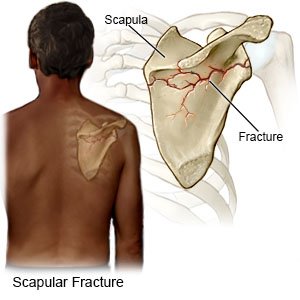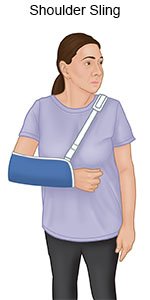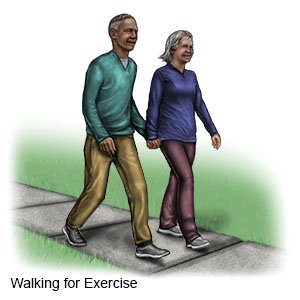Scapular Fracture
Medically reviewed by Drugs.com. Last updated on Aug 4, 2025.
AMBULATORY CARE:
A scapular fracture
is a break in your shoulder blade (scapula). Your collarbone, arm bones, lungs, or chest may also be affected.
 |
Common signs and symptoms:
- Pain, tenderness, swelling, bruising, or a bump in the injured area
- Trouble moving your shoulder and arm
- Bones poking through your skin, or bones not looking normal
- Weak, numb, and tingly shoulder and arm
- The need to support your arm with your other hand to decrease pain
Call your local emergency number (911 in the US) if:
- You suddenly feel lightheaded and short of breath.
- You have chest pain when you take a deep breath or cough.
- You cough up blood.
Seek care immediately if:
- You cannot move your fingers.
- Any part of your arm becomes blue, pale, cold, or numb.
- Your pain is not relieved or gets worse, even after you take pain medicine.
- Your arm feels warm, tender, and painful. It may look swollen and red.
Call your doctor or orthopedist if:
- You have a fever.
- You have more swelling than you did before your arm was put into a sling.
- Your skin is itchy, swollen, or has a rash.
- You have questions or concerns about your condition or care.
Treatment
will depend on the damage and the kind of fracture you have. Most broken scapulas heal on their own.
- Medicines may be given to prevent or treat pain or a bacterial infection.
- A sling may be used to hold your arm in place and support your scapula while it heals.

- Physical therapy may be needed after your swelling and pain have improved. A physical therapist can teach you exercises to help improve movement and strength.
- Surgery may be used to place your bones back in their normal position if the fracture is severe. Pins, plates, and screws may be used to hold the bone together. Other problems may also need to be treated, such as an injury to a nerve, blood vessel, or other organs.
Self-care:
- Rest when you feel it is needed. Slowly start to do more each day. Return to your daily activities as directed.
- Apply ice to help decrease swelling and pain, and to prevent tissue damage. Use an ice pack, or put crushed ice in a plastic bag. Cover it with a towel and place it on your scapula. Apply ice for 15 to 20 minutes every hour, or as directed.
- Ask about activity before you start to exercise. Start slowly and do more as you get stronger. Exercise will help make your bones and muscles stronger. Do not play contact sports, such as football and wrestling, while your scapula is still healing. Ask your healthcare provider or orthopedist when you can start playing contact sports.

- Go to physical therapy, if directed. You may need physical therapy after your swelling and pain have improved. A physical therapist will teach you exercises to help improve movement and strength.
Sling care:
Keep your sling clean, and adjust it so that your arm is comfortable.
Follow up with your doctor or orthopedist within 2 to 3 days, or as directed:
Write down your questions so you remember to ask them during your visits.
© Copyright Merative 2025 Information is for End User's use only and may not be sold, redistributed or otherwise used for commercial purposes.
The above information is an educational aid only. It is not intended as medical advice for individual conditions or treatments. Talk to your doctor, nurse or pharmacist before following any medical regimen to see if it is safe and effective for you.
Further information
Always consult your healthcare provider to ensure the information displayed on this page applies to your personal circumstances.
